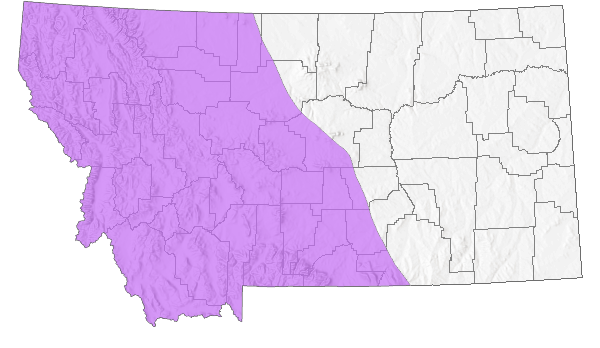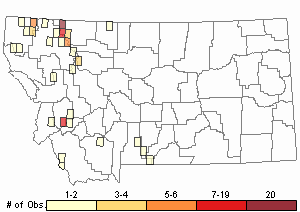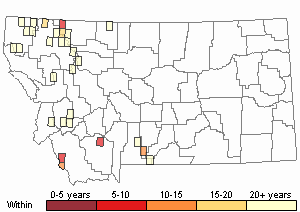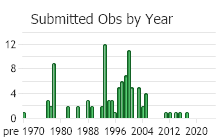View in other NatureServe Network Field Guides
NatureServe
Montana
Utah
Wyoming
Idaho
Wisconsin
British Columbia
South Carolina
Yukon
California
New York
Common Moonwort - Botrychium lunaria
Other Names:
Botrychium neolunaria sp. nov. ined.
Native Species
Global Rank:
G5
State Rank:
S4
(see State Rank Reason below)
C-value:
4
Agency Status
USFWS:
USFS:
BLM:
External Links
State Rank Reason (see State Rank above)
See rank details.
- Details on Status Ranking and Review
Population Size
Score1-2 - Small to Moderate. Population size is imprecisely known but is believed to be >2,000 individuals and <100,000 individuals.
Range Extent
Score0 - Widespread species within Montana (occurs in 5% or more of the state or generally occurring in 6 or more sub-basins.) as well as outside of Montana.
Area of Occupancy
Score0 - High: Occurs in >25 Subwatersheds (6th Code HUC’s).
Environmental Specificity
Score0-1 - Low to Moderate.
Trends
Score0-1 - Stable to Minor Declines:
CommentActual trends are unknown, though the likelihood of severe declines appears to be minor.
Threats
Score0-1 - Low to Medium.
Intrinsic Vulnerability
Score1-2 - Moderate to High Vulnerability.
Raw Conservation Status Score
Score
2 to 7 total points scored out of a possible 19.
General Description
Moonwort is a very small, perennial fern with a single aboveground frond. The dark-green frond is usually about 4 inches long and can be seen through mid-summer. It is divided into two leaves above a common stalk. The sterile leaf is usually dark green, thick, and fleshy. It has up to 9 usually overlapping pairs of broadly fan-shaped leaflets (pinnae). The top edges are rounded and smooth or wavy or rarely have teeth. The fertile leaf is longer than the sterile leaf with branches that bear grape-like sporangia. Spores germinate underground and develop into tiny, non-photosynthetic gametophytes which depend on an fungus for nourishment. Our plants are variety crenulatum (Donald Farrar; Iowa State Univeristy, unpublished).
Phenology
Leaves appearing in midspring, dying in latter half of summer.
Diagnostic Characteristics
The name Botrychium neolunaria sp. nov. ined. will likely replace the name B. lunaria within North America as unpublished research has shown that material from N.A. is "greatly different genetically" from Eurasian material (Farrar 2011).
Species Range
Montana Range
Range Descriptions

 Native
Native
Range Comments
In MT in the western third of state east to Park County; subspecies crenulatum occurs from BC and AB south to CA, NV, UT, and east to WY with disjunct occurrences in northern MN and the souther end of Hudson Bay in ON and QC (Donald Farrar, Iowa State University, unpublished).
Observations in Montana Natural Heritage Program Database
Number of Observations: 95
(Click on the following maps and charts to see full sized version)
Map Help and Descriptions
Relative Density

Recency



 (Observations spanning multiple months or years are excluded from time charts)
(Observations spanning multiple months or years are excluded from time charts)
Habitat
Various mesic sites from low to moderate elevations, including roadsides and other disturbed habitats. Sites are generally open with montane meadows and grasslands being the most common habitats occupied by the species.
Stewardship Responsibility
References
- Additional ReferencesLegend:
 View Online Publication
View Online Publication
Do you know of a citation we're missing? Farrar, Donald. 2011. Moonwort (Botrychium) Systematics. Ada Hayden Herbarium. Iowa State University.
Farrar, Donald. 2011. Moonwort (Botrychium) Systematics. Ada Hayden Herbarium. Iowa State University. Lesica, P., M.T. Lavin, and P.F. Stickney. 2012. Manual of Montana Vascular Plants. Fort Worth, TX: BRIT Press. viii + 771 p.
Lesica, P., M.T. Lavin, and P.F. Stickney. 2012. Manual of Montana Vascular Plants. Fort Worth, TX: BRIT Press. viii + 771 p. Lesica, P., M.T. Lavin, and P.F. Stickney. 2022. Manual of Montana Vascular Plants, Second Edition. Fort Worth, TX: BRIT Press. viii + 779 p.
Lesica, P., M.T. Lavin, and P.F. Stickney. 2022. Manual of Montana Vascular Plants, Second Edition. Fort Worth, TX: BRIT Press. viii + 779 p. Mantas, M. and R.S. Wirt. 1995. Moonworts of western Montana (Botrychium subgenus Botrychium). Flathead National Forest. 103 pp.
Mantas, M. and R.S. Wirt. 1995. Moonworts of western Montana (Botrychium subgenus Botrychium). Flathead National Forest. 103 pp. Schmid, E. and F. Oberwinkler. 1994. Light and electron microscopy of the host-fungus interaction in the achlorophyllous gametophyte of Botrychium lunaria. Canadian Journal of Botany 72: 182-188.
Schmid, E. and F. Oberwinkler. 1994. Light and electron microscopy of the host-fungus interaction in the achlorophyllous gametophyte of Botrychium lunaria. Canadian Journal of Botany 72: 182-188. Wagner, W.H., Jr. and P.L. Lord. 1956. The morphological and cytological distinctness of Botrychium minganense and B. lunaria in Michigan. Bulletin of the Torrey Botanical Club 83(4): 261-280.
Wagner, W.H., Jr. and P.L. Lord. 1956. The morphological and cytological distinctness of Botrychium minganense and B. lunaria in Michigan. Bulletin of the Torrey Botanical Club 83(4): 261-280.
- Web Search Engines for Articles on "Common Moonwort"





